
In the world of cryptocurrencies, the term “ecosystem” holds significant importance. A crypto ecosystem is a complex network of processes, participants, and technologies that form the foundation of the cryptocurrency market. Understanding the concept of ecosystems in crypto is paramount for anyone looking to explore and capitalize on the potential of digital assets. In this comprehensive article, we will delve into what a crypto ecosystem entails, examine its core components, and highlight its crucial role in shaping the future of finance and beyond.
This article will use several non-crypto examples to aid in better visualization.
Definitions of Ecosystem in Various Contexts
Natural Ecosystem
In the realm of nature, an ecosystem represents a complete, autonomous system composed of living organisms (biotic) and non-living elements (abiotic) such as air, water, and mineral-rich soil (collectively known as the environment). Within this intricate web of interactions, organisms coexist and depend on each other, playing a crucial role in maintaining ecological harmony and supporting life on our planet.
Business Ecosystem
Within the business landscape, a business ecosystem refers to a network of interconnected value chains comprising multiple products and services in a specific industry. This collaborative ecosystem endeavors to provide comprehensive solutions that cater to customers’ needs and desires.
For instance, consider Apple’s business ecosystem, which encompasses a value chain in the technology industry. It includes various products such as iPhone, iPad, iMac, headphones, watches,…

The Significance of Ecosystem in Business
It is no coincidence that all major business empires today strive to build their own ecosystem. This approach brings numerous benefits to both users and companies:
For Users:
- An ecosystem serves to fulfill all its needs comprehensively.
- The ecosystem’s products are synchronized, interacting with each other, creating convenience and ease of use.
For Projects:
- An ecosystem aids in expanding the scale of the business, building a value chain from inputs to outputs.
- It leverages existing resources, such as infrastructure and user data,…
Especially when a project has developed a complete ecosystem, users tend to stay loyal, having no need or desire to use external services. With a user base, the company gains valuable insights, enabling continuous improvement and expansion of its ecosystem.
Let’s take the Apple ecosystem as an example, consisting of products like iPhone, iPad, iMac, MacBook, Apple Watch, AirPods, and Apple TV.
Apple has developed a comprehensive range of products catering to various technology needs of users, including smartphones, tablets, headphones, watches, and televisions.
These products run on the iOS operating system and are connected through iCloud, allowing seamless device interaction. Users can manage their data across different products.
Consequently, users tend to remain loyal to the brand once they adopt Apple products. Switching to another brand would be inconvenient.
Thus, Apple has successfully built a complete and interconnected ecosystem where users find all their needs met within the Apple ecosystem, eliminating the need for external solutions.
For competitors to challenge Apple, they cannot compete with just one product; they must build an entire ecosystem, a challenging task.
What is the Crypto Ecosystem?
The crypto ecosystem represents a complex system of interconnected and supportive products within a blockchain. Each blockchain aims to develop a comprehensive ecosystem while providing essential infrastructure.
The critical components required for a thriving crypto ecosystem are:
- Transactions & Payment Services: Facilitating secure transactions and seamless payments, including tokens, smart contracts, and wallets.
- DeFi (Decentralized Finance): Providing decentralized financial services like trading, borrowing, lending, and savings through stablecoins, decentralized exchanges (DEXs), and more.
- Social & Entertainment: Fostering community interaction and entertainment through NFTs, blockchain-based gaming platforms, and gambling applications.
- Enterprise Blockchain Solutions: Extending the ecosystem to real-world applications in finance, supply chain management, healthcare, education, and more.
Each component contributes to the growth and maturity of the crypto ecosystem, offering users a diverse array of products and services.
The Functioning of the Cryptocurrency Ecosystem
The cryptocurrency ecosystem operates as an efficient and interconnected network where participants work together to ensure seamless functionality. The foundation is the blockchain protocol, developed by skilled blockchain developers, defining roles and features for optimal operation.
Upon launch, miners or stakes update and verify transactions, while crypto exchanges provide a platform for investors. Crypto media disseminates information, benefiting all stakeholders.
In this dynamic ecosystem, the crypto industry thrives, presenting new opportunities for growth and innovation while meeting diverse needs.
Characteristics of Cryptocurrency Ecosystems
Cryptocurrency ecosystems possess distinct and valuable characteristics that contribute to their widespread appeal:
- Decentralization
The fundamental aspect that drives the popularity of cryptocurrencies is their decentralized and unregulated nature. Instead of relying on a central authority, these digital assets function on distributed networks of computer nodes, ensuring transparency and reducing the risk of control by any single entity.
- Security
Cryptocurrencies leverage advanced cryptographic techniques to provide robust security against data manipulation, theft, and hacking attempts. Transactions are validated using private keys, which also serve as proof of ownership for blockchain addresses. These security features safeguard users’ funds from unauthorized access and fraudulent activities.
- Immutability
A core feature of cryptocurrencies is immutability, ensuring that once transactions are recorded on the blockchain, they cannot be altered or tampered with clandestinely. This characteristic instills trust in the system, assuring users that their transactions and ownership rights are secure and tamper-proof.
- Anonymity
In decentralized cryptocurrency networks, users are not required to disclose their identities during transactions. Only a digital identity (which can remain anonymous) and access to a digital wallet are needed to participate in the ecosystem. This emphasis on privacy appeals to users seeking financial autonomy and confidentiality.
By combining these key characteristics, cryptocurrency ecosystems offer a secure, transparent, and private environment for users to engage in digital transactions and manage their assets independently. These qualities have led to the rapid growth and adoption of cryptocurrencies across various industries and use cases.
The Benefits of Crypto Ecosystems for Organizations
The rise of cryptocurrencies and blockchain technology offers organizations numerous advantages. Blockchains enhance operational efficiency, reduce costs, and improve customer experience. Organizations can streamline processes by eliminating intermediaries, leading to more direct and efficient interactions. Moreover, the inherent security of blockchains minimizes fraud risks, making them a secure and cost-effective alternative for information exchange among stakeholders.
Crypto ecosystems present promising opportunities for organizations to optimize operations, enhance trust, and adapt to the evolving digital landscape.
Prominent Crypto Ecosystems in the Present Era
Generally, existing blockchains are classified into three main tiers:
- Top Tier 1: This category comprises Ethereum and Binance Smart Chain (BSC). Both ecosystems have established themselves robust and feature-rich, serving as benchmarks for comparison with smaller projects.
- Top Tier 2: This tier includes Solana, Avalanche, and Polkadot. While these ecosystems show immense potential, they require further development to comprehend fully.
- Top Tier 3: These are relatively new ecosystems, some with limited development progress, such as Near, Cardano, and Dfinity.
Below are the top-performing and most promising crypto ecosystems (brief introductions without detailed reviews):
Ethereum Ecosystem
Currently, the largest crypto ecosystem is Ethereum. It serves as the first smart contract platform, providing a competitive advantage that has led to a strong developer community. Ethereum is known for being developer-friendly, with the Ethereum Virtual Machine (EVM) simplifying the deployment of decentralized applications (dApps).
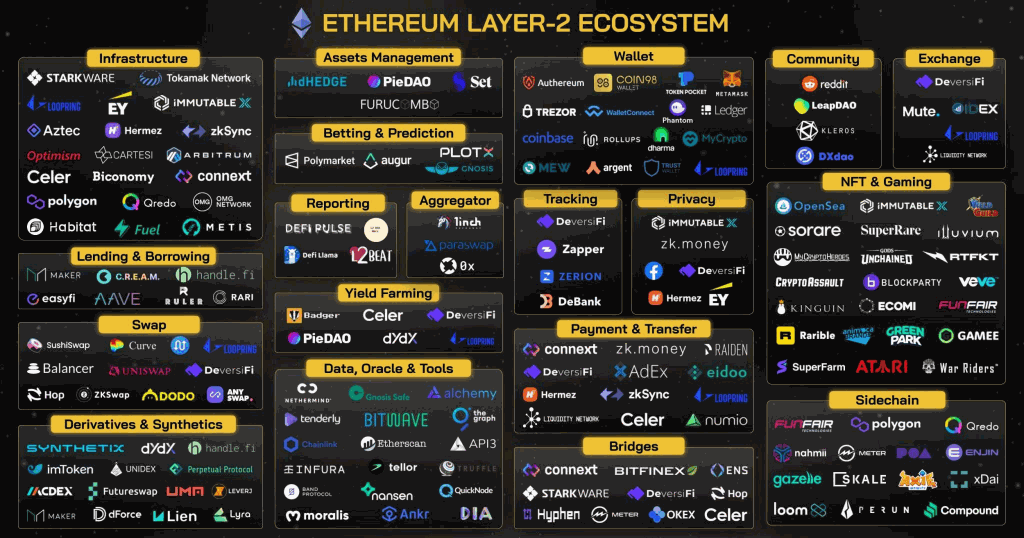
Consequently, the Ethereum ecosystem hosts numerous renowned projects. Many of today’s popular cryptocurrencies run on the Ethereum blockchain, such as:
- Uniswap (UNI): A decentralized exchange (DEX) and automated market maker (AMM) on the Ethereum blockchain.
- Aave (AAVE): The first decentralized finance (DeFi) application enabling users to borrow and lend various cryptocurrencies, including stablecoins and altcoins.
- Curve (CRV): A decentralized exchange (DEX) designed for efficient stablecoin trading with low risk.
- Shiba Inu (SHIB) is currently one of the most famous meme coins.
- Decentraland (MANA): A leading game project in the metaverse.
Binance Smart Chain (BSC) Ecosystem
Binance Smart Chain is a strong contender, competing with Ethereum. It stands out as not only a blockchain but also a renowned cryptocurrency exchange, Binance.
With its smart contract capabilities, Binance Smart Chain is among Ethereum’s top competitors. The Binance ecosystem encompasses a broader range, including a blockchain project incubator, a token launch platform, and the digital wallet Trust Wallet,…
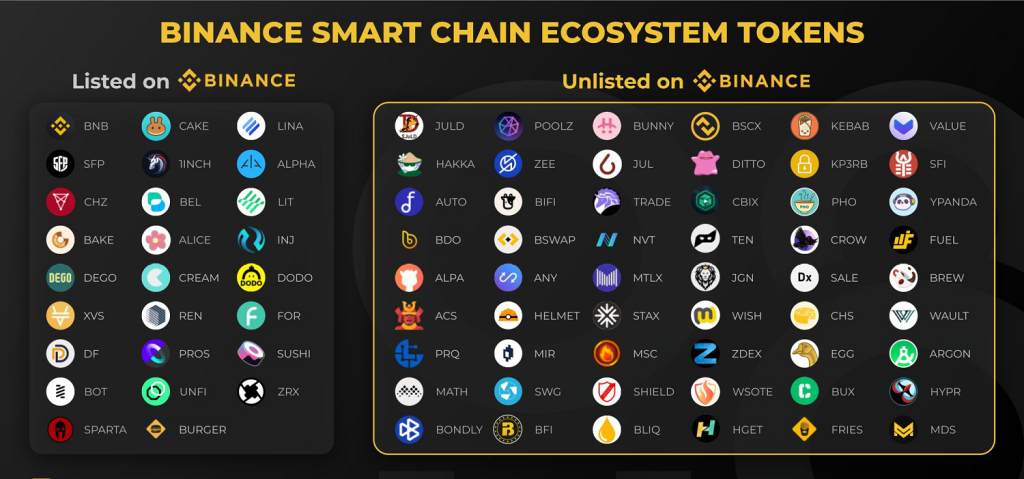
Cardano Ecosystem
Founded in 2015 by Charles Hoskinson – one of the co-founders of Ethereum and BitShares – Cardano is a decentralized blockchain that shares similarities with Ethereum. Like Ethereum, Cardano allows developers to create smart contracts and deploy dApps with enhanced security and scalability.

Although Cardano is relatively newer than Ethereum and Bitcoin, it has made significant progress in completing various components, including Lending, Oracle, DEX, and Wallet.
Solana Ecosystem
Currently recognized as the fastest-growing blockchain network, Solana boasts impressive transaction speeds, handling up to 50,000 transactions per second at an average cost of only $0.00025. This makes it one of the market’s fastest and most cost-efficient platforms.
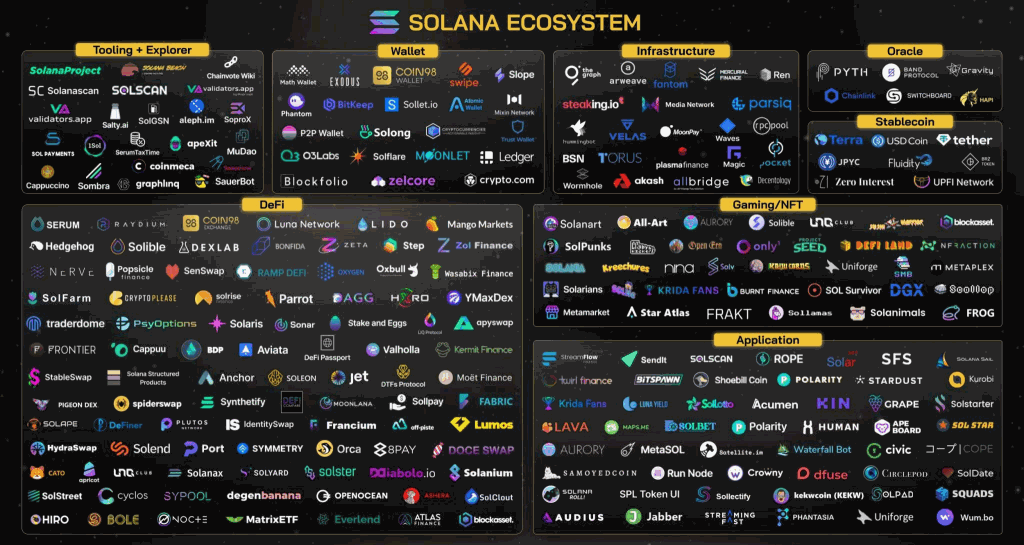
With its exceptional scalability and speed, Solana positions itself as a leading “Ethereum Killer.” Notable applications on Solana include Initial Litigation Offerings DEXs, Private Securities, Synthetics, Prediction Markets, Stablecoins, and DeFi projects.
Polkadot Ecosystem
Unlike other crypto ecosystems that compete directly with Ethereum, Polkadot aims to be a complementary partner to various blockchain platforms. It allows interaction with DApps within its ecosystem and offers applications to connect with other blockchains, such as Ethereum and Bitcoin, through bridges.
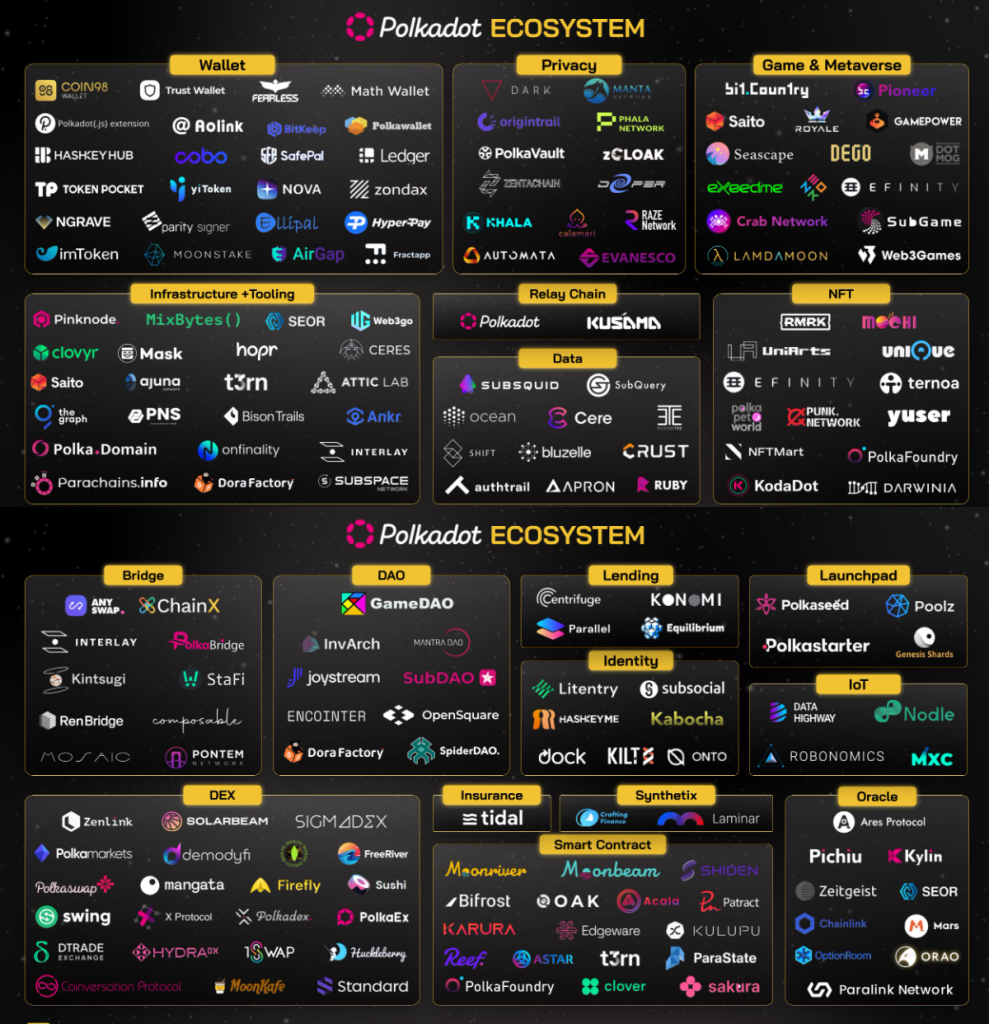
Polkadot is relatively young in its development. However, it has made substantial progress in core DeFi components, such as Stablecoin, DEX, Oracle, Lending and Borrowing, and Yield Farming, laying the foundation for future growth.
Avalanche Ecosystem
Currently comprised of three core blockchains optimized for specific tasks, Avalanche shows excellent promise in scalability and transaction speed, reaching up to 4,500 transactions per second.
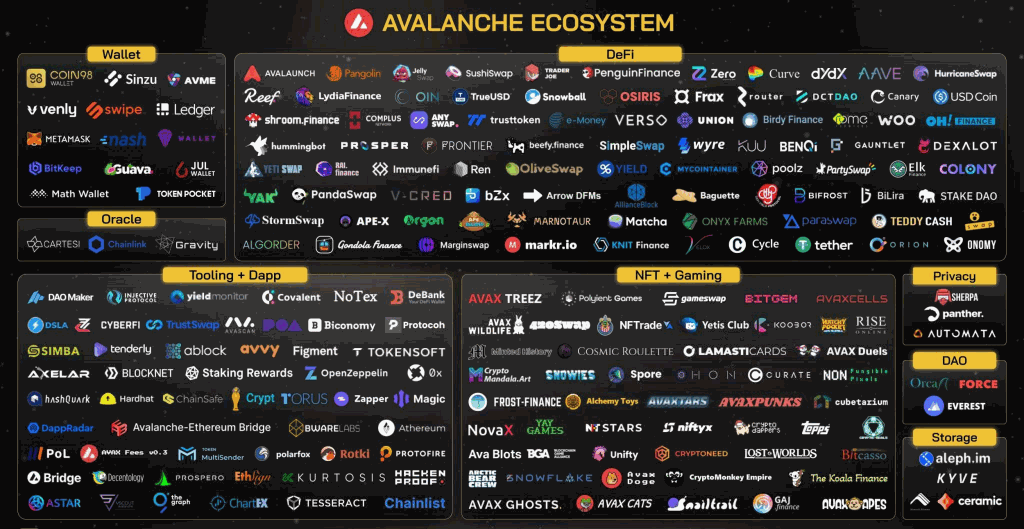
Its high throughput allows rapid transactions under one second while maintaining decentralization and security. Avalanche is an excellent platform for DeFi and payment solutions, rapidly catching up with other established ecosystems.
TRON Ecosystem
TRON is a well-known crypto ecosystem, particularly among long-time players, alongside Ethereum and Binance Smart Chain. Established in 2017, TRON is a Smart Contract Platform inspired by Ethereum, providing high scalability and bandwidth for developers to create smart contracts and dApps.
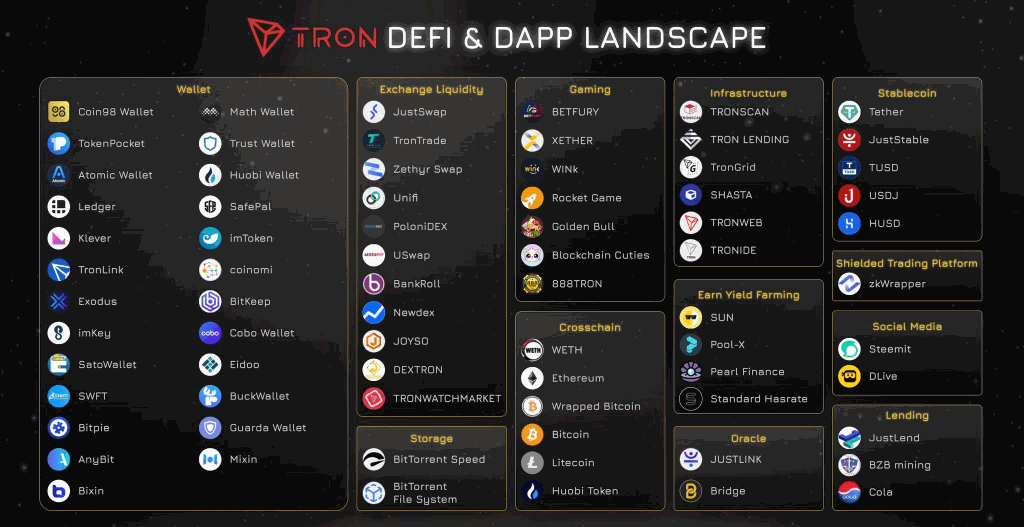
Though TRON may not have as many dApps as BSC or Ethereum, its DeFi components, such as Stablecoin, DEX, and Lending, are developing well and garnering significant media attention.
Algorand Ecosystem
Algorand is a decentralized blockchain launched in 2019 by MIT Professor Silvio Micali. It aims to address issues related to current blockchain platforms, focusing on scalability, decentralization, and security.

While Algorand is relatively new, with fewer applications in each segment, it has a solid foundation with critical components, offering high scalability and security without sacrificing decentralization. This makes it an attractive choice for organizations and enterprises in the future.
NEAR Ecosystem
In the race of ecosystems, NEAR Protocol is undoubtedly a promising contender. NEAR is a sharded blockchain with simple first-layer proof-of-stake consensus, making it highly user-friendly, scalable, and secure. It caters to developers and businesses with application solutions and robust security for valuable assets such as identities and funds.
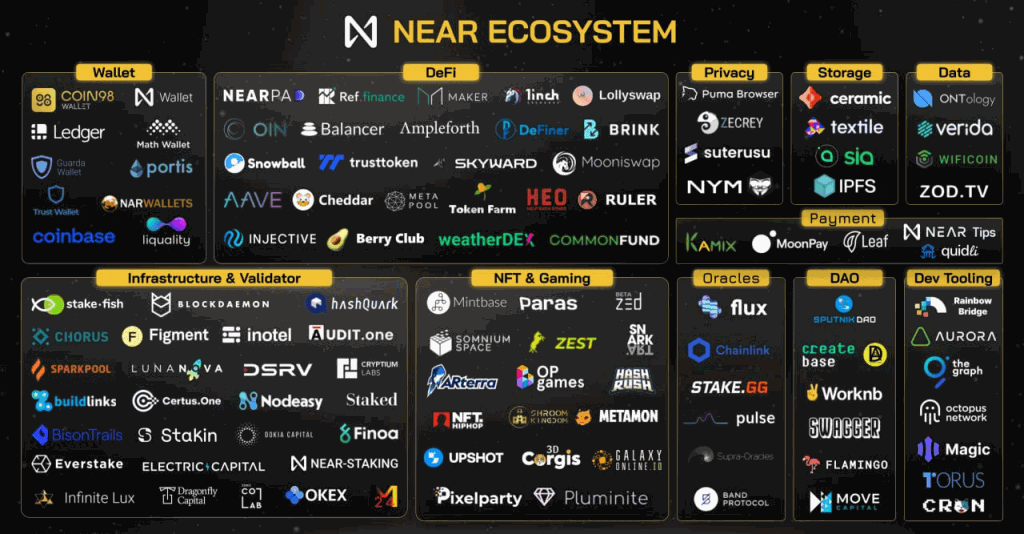
Presently, NEAR’s transaction fees and speeds are pretty impressive, with an average fee of around $0.1 (compared to $0.5 for Avalanche and $0.3 for Tron, for instance). NEAR fully supports and is compatible with the Ethereum Virtual Machine (EVM), enabling developers to migrate dApps from Ethereum to NEAR Protocol through Aurora seamlessly.
With completed bridges, the NEAR ecosystem is gradually taking shape and poised to attract significant investment, given the proper stimulating measures.
Fantom Ecosystem
Fantom is a potential blockchain ecosystem utilizing the Lachesis mechanism – an advanced aBFT consensus algorithm based on DAG. This allows Fantom-based blockchains to be fast, secure, and highly scalable.
Fantom’s Lachesis focuses more on speed and less on hierarchy compared to other protocols like Bitcoin’s Proof of Work, prioritizing security and decentralization. Consequently, Fantom processes transactions in mere seconds with low fees, surpassing many other blockchains.

Investment Opportunities in Blockchain Ecosystems
Investors now have exciting opportunities in various blockchain ecosystems. The key to success for blockchain networks lies in building robust ecosystems that comprehensively cater to users’ needs and maintain their loyalty. Thriving ecosystems attract developers, users, and businesses, driving adoption and growth.
Furthermore, investing in emerging blockchain projects with missing ecosystem components can be highly rewarding. Supporting these projects as they develop and fill the gaps can yield significant returns.
Investors should adopt a strategic approach to seize these opportunities and stay informed about the rapidly evolving blockchain space. With well-informed decisions, they can position themselves for long-term success in this dynamic market.
Conclusion
Blockchain ecosystems are the foundation of the cryptocurrency market’s future. They fulfill user needs comprehensively, offer significant investment opportunities, and drive innovation in various industries. With their decentralized, secure, and transparent nature, these ecosystems are poised to reshape finance and beyond. Prominent ecosystems like Ethereum, Binance Smart Chain, Cardano, and NEAR lead the way, while emerging projects hold great potential for investors seeking high returns. As the blockchain space evolves rapidly, staying informed and strategically investing is critical to long-term success in this dynamic market.


